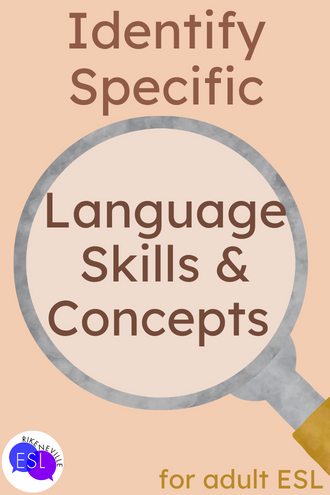
Assessing adult ESL students’ progress can be a challenging task, but with the right approach and tools, you can do it effectively. It’s important to clearly understand how to evaluate our students’ language skills to track their progress and improve our teaching practice effectively. This was something I knew nothing about when I first started teaching, and my guess is that you are in my past shoes and looking for some help that is more practical than theoretical. Keep reading!
In addition to some practical steps, you’ll read about other considerations, such as using assessment results to inform your teaching practice and reflecting on your own practice to improve. By the end of this article, you will have a better understanding of how to assess adult ESL students effectively.
Before assessing adult ESL students, identify the specific language skills and concepts you want to evaluate. Make sure they are aligned with your students’ goals and needs, relevant to their everyday lives, and the context in which they will be using the language.
Here are some examples of common student goals and needs and what would align with them:

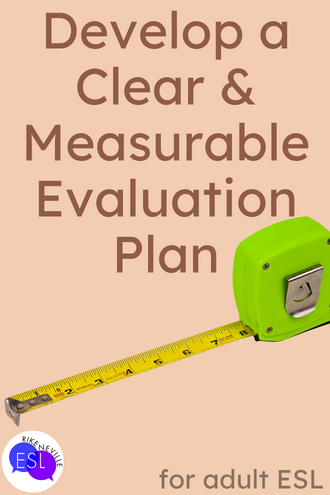
Once you have identified the language skills and concepts to evaluate, develop a clear and measurable evaluation plan that outlines the specific criteria, standards, and methods you will use when assessing adult ESL students’ progress. This will help ensure consistency and fairness in the assessment process.
Here are a couple of example plans for assessing adult ESL students on their improvement of academic vocabulary knowledge:
Academic Vocabulary Evaluation Plan 1:
Academic Vocabulary Evaluation Plan 2:
Both evaluation plans focus on specific criteria, standards, and methods for assessing adult ESL students’ progress in improving academic vocabulary. The first plan focuses on vocabulary size, use, and retention, while the second focuses on vocabulary breadth, depth, and flexibility.
Here are a couple of example plans for assessing adult ESL students on their improvement of conversational English skills:
Conversational Skills Evaluation Plan 1:
Conversational Skills Evaluation Plan 2:
These evaluation plans focus on specific criteria, standards, and methods for assessing adult ESL students’ progress in improving conversational skills. The first plan focuses on fluency, vocabulary, pronunciation, and grammar, while the second focuses on interaction skills, pragmatics, sociolinguistics, and idiomatic expressions. Unless your students have the same goals, create an evaluation for each student or group that aligns with their specific goals and teaching methods.
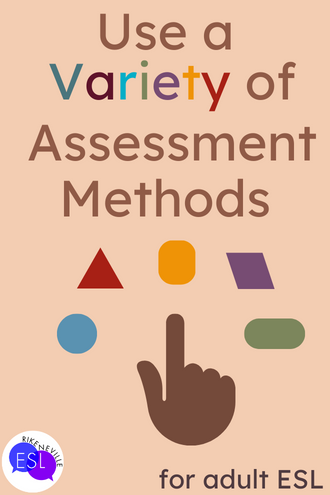
Using various assessment methods can provide a more comprehensive understanding of student performance in different language skills and concepts. This is because each method has its own strengths and weaknesses. Using multiple methods can help mitigate those weaknesses and provide a more accurate picture of student progress and understanding.
For example, using quizzes and tests can provide a quick and efficient way to measure student understanding of specific language skills and concepts, but they might not give an accurate measure of student performance in more complex tasks such as speaking or writing. On the other hand, presentations or self-assessment activities can provide a more authentic measure of student performance in these tasks. Still, they may take more time and resources to administer.
Examples of different assessment methods are:
By using a combination of these methods, teachers can better understand student progress and different language skills and concepts. Additionally, using different assessment methods can keep students engaged and motivated by providing them with opportunities to demonstrate their knowledge and skills differently.
To effectively assess and evaluate adult ESL students’ progress and understanding, you can use a variety of assessment methods, such as quizzes, tests, presentations, or self-assessment activities. Additionally, providing regular feedback and support to students based on their progress and needs and involving them in the assessment and evaluation process can help them take ownership of their own learning.
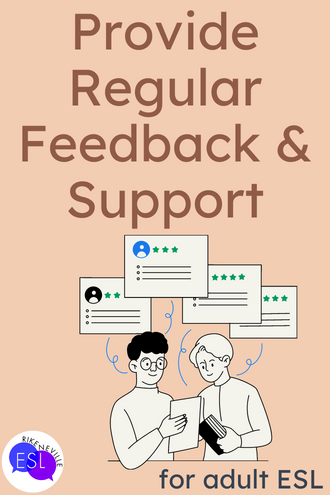
One effective way to provide feedback is through verbal or written comments on quizzes, tests, presentations, or other assessments or through one-on-one or small-group meetings with the teacher. Giving feedback regularly, such as after each assignment or assessment, will help students stay on track with their learning and make progress over time.
Involving students in the assessment and evaluation process can also help them take ownership of their own learning. This can be done by:
Creating and using rubrics is another important aspect of providing effective assessment and evaluation for adult ESL students. A rubric is a tool that outlines the criteria, standards, and levels of performance for a specific task or assignment. You can use it for assessing adult ESL students on their performance in a wide range of language skills and concepts, such as writing, speaking, listening, or reading.
Rubrics help to provide clear and objective criteria for evaluating student performance, and you can use them to communicate those criteria to your students in advance of the assignment or assessment. This allows your students to understand exactly what is expected of them and to focus their efforts on meeting those expectations.
It’s also crucial to provide regular support to your students based on their progress and needs, including additional resources, extra practice materials, or one-on-one tutoring sessions. Additionally, creating a positive and supportive learning environment that encourages your students to take risks and persevere in the face of challenges is also important.
Providing feedback when assessing adult ESL students on their progress is an important aspect of the assessment process. It helps students understand their strengths and weaknesses and provides guidance on how they can improve. Here are a few key tips to keep in mind when giving feedback to adult ESL students:
By following these tips, you can provide specific, positive, actionable, and timely feedback that fosters a sense of accountability in the student. It will help them understand their progress and take steps to improve their language skills.
Coordinating and sharing assessment and evaluation information with other teachers and support staff can provide comprehensive and consistent support for adult ESL students. This can ensure that students receive the support they need to succeed in their language learning goals, regardless of which class or program they are enrolled in.
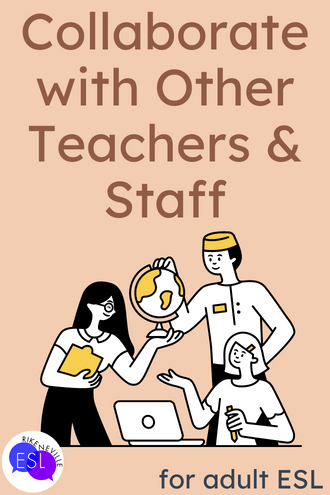
When teachers and support staff share assessment and evaluation information, they can better understand each student’s strengths and areas for improvement. This can help them to identify specific areas where students may need additional support or interventions and tailor their instruction and support accordingly.
Sharing information can also ensure that students receive consistent and coherent instruction across different classes and programs. For example, suppose your student needs help with a specific language skill or concept in one class. In that case, you can share that information with other teachers and support staff to ensure that the student receives consistent and appropriate support in other courses or programs as well.
There are several ways to share assessment and evaluation information with other teachers and support staff:
It’s also important to note that sharing assessment and evaluation information should be done in compliance with student data privacy laws and regulations. Teachers and support staff should also obtain consent from students before sharing their information with others.
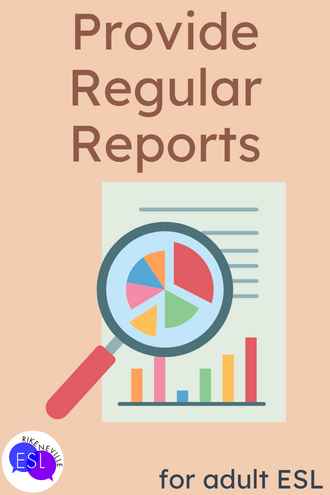
When assessing adult ESL students, be sure to provide regular reports and updates to students, their families, and other relevant stakeholders on student progress and achievement. It helps keep everyone informed about the student’s progress and allows the student to understand their own progress.
One way you can provide regular reports is by sending out progress reports or report cards at regular intervals, such as every semester or every quarter. These reports should include information on the student’s performance in different language skills and concepts and any areas where they may be excelling or struggling. You can also use it as an opportunity to provide feedback and suggestions for improvement.
Another way to provide regular updates is by holding parent-teacher conferences, where you can discuss student progress and achievements in more detail. This can be an excellent opportunity to involve parents and other relevant stakeholders in the assessment and evaluation process and to get their feedback and suggestions on how to support the student’s learning best.
It’s also important to involve your students in the assessment and evaluation process. By sharing their progress reports with them and discussing their performance with them, you can help them understand their strengths and areas for improvement and empower them to take an active role in their learning.

Using assessment and evaluation results to inform your teaching practice is a great way to ensure that your students get the support and guidance they need to succeed in their language learning goals. When you take the time to analyze and understand the results, you can identify areas where your students are struggling and develop targeted support and interventions to help them improve.
One way to use the results to inform your teaching practice is by identifying patterns in student performance. For example, if several students are struggling with the same grammar concept, you can use this information to adjust your instruction and provide additional practice opportunities for that concept. You can also use the results to identify students who may need extra help or guidance and provide them with targeted support and interventions.
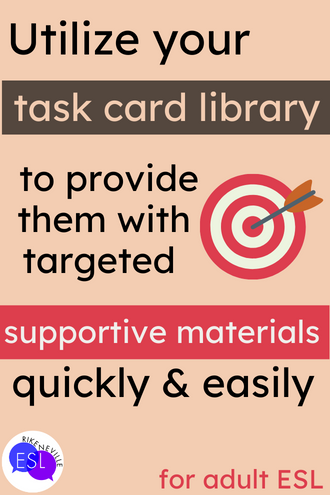
If you have been building your task card library, you’ll be able to provide them with targeted supportive materials easily and quickly.
Another great way to use the results to inform your teaching practice is by involving your students in the process. By sharing the results with them and discussing them together, you can help them understand their strengths and areas for improvement and allow them to take an active role in their own learning. You can also ask them for feedback on your instruction and the assessments you are using, which can help you to improve your teaching practice.
Overall, using assessment and evaluation results to inform your teaching practice is an effective way to ensure that your students get the support and guidance they need to succeed in their language learning goals. Using the results to identify student performance patterns and develop targeted support and interventions, you can help your students overcome challenges and progress in their language learning. By involving your students in the process, you can also empower them to take an active role in their own learning and allow them to provide valuable feedback on your instruction.
Caveat:
Remember that having a friendly and positive attitude when discussing the results with your students is essential, as this can help create an open and supportive learning environment. It’s also important to remember that every student is different, and each student will have unique strengths and areas for improvement. By keeping this in mind, you can work with your students to develop personalized support and interventions to help them succeed in their language learning goals.
Continuously reflecting on and improving your assessment and evaluation methods and practices is key to providing effective support for adult ESL students. Be aware that teaching and assessment practices are constantly evolving and that new methods are always emerging. By continuously reflecting on your own practices, you can ensure that you use the most effective and current techniques to support your students’ learning.
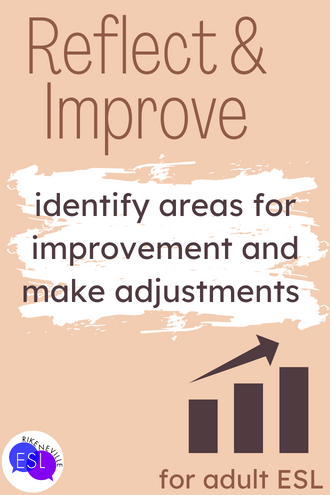
One way to reflect on your assessment and evaluation methods is by reviewing the results you’ve obtained from your students. This can help you identify areas where your students are excelling and where they may be struggling. By looking at the results, you can also pinpoint any patterns in student performance, which can help you identify areas where you need to adjust your instruction and assessment.
Another way to reflect on your assessment and evaluation methods is by soliciting feedback and suggestions from your students and other stakeholders. This can include gathering feedback from your students on their experience with the assessments and evaluations and seeking input from other teachers and support staff on their effectiveness. By gathering feedback, you can identify areas where you can improve your methods and make adjustments to support your students’ learning.
Remember, being open to feedback and suggestions is crucial. By being receptive to feedback, you can ensure that your methods are effective and responsive to the needs of your students. Additionally, being open to feedback can create a positive and supportive learning environment where your students feel comfortable giving their honest opinions and suggestions.
By following these steps, assessing adult ESL students will come more easily to teachers who want to provide targeted support and interventions to help them achieve their goals.
This is the second in my series of articles for new adult ESL students. The first is Teaching Adult ESL: Insights and Helpful Strategies for Navigating the Journey.
Looking for practical and fun adult ESL teaching material? Drop by my TpT store beginner to adult grammar, vocabulary, role plays, discussion topics, pronunciation, and more!
For other teaching tips, try these: